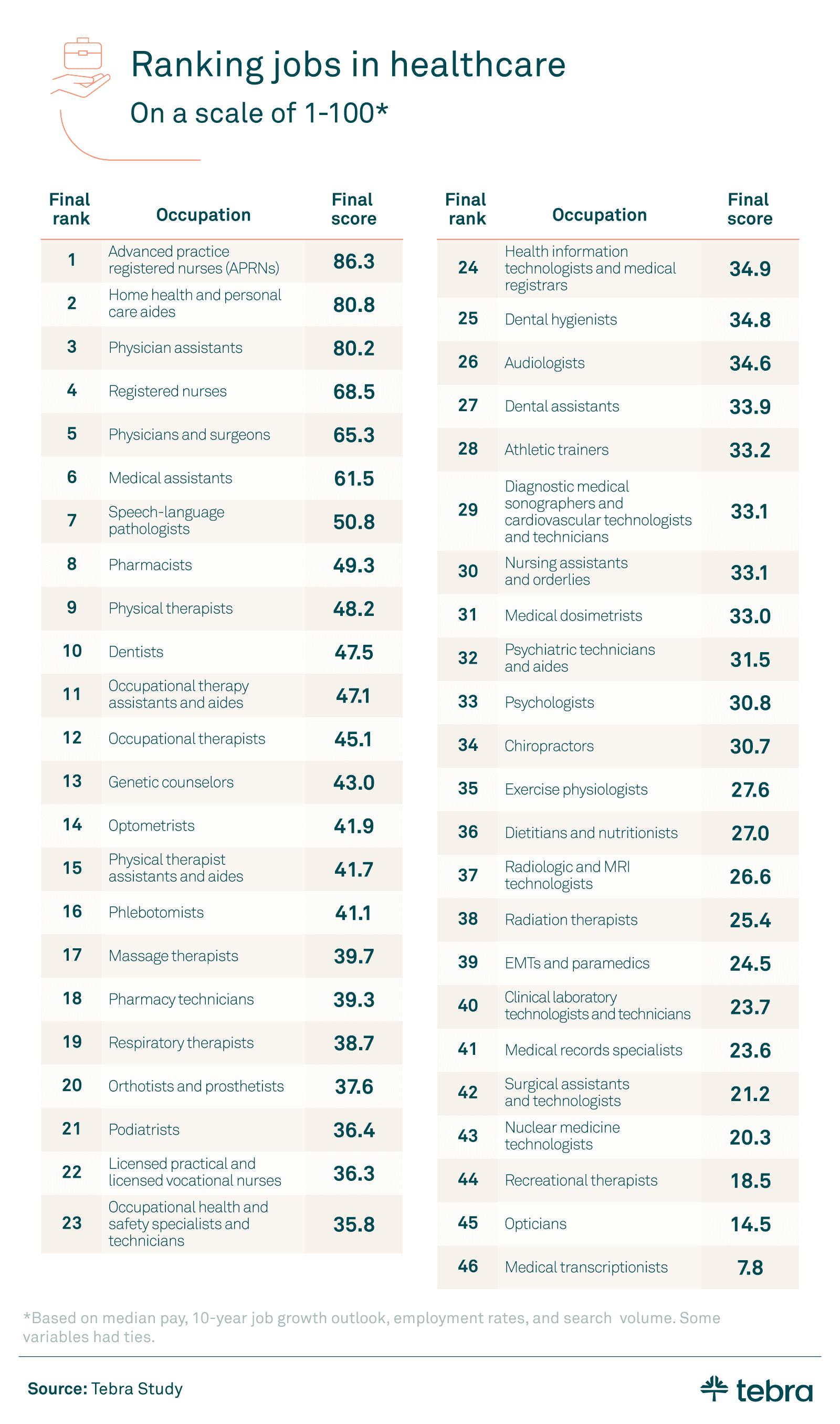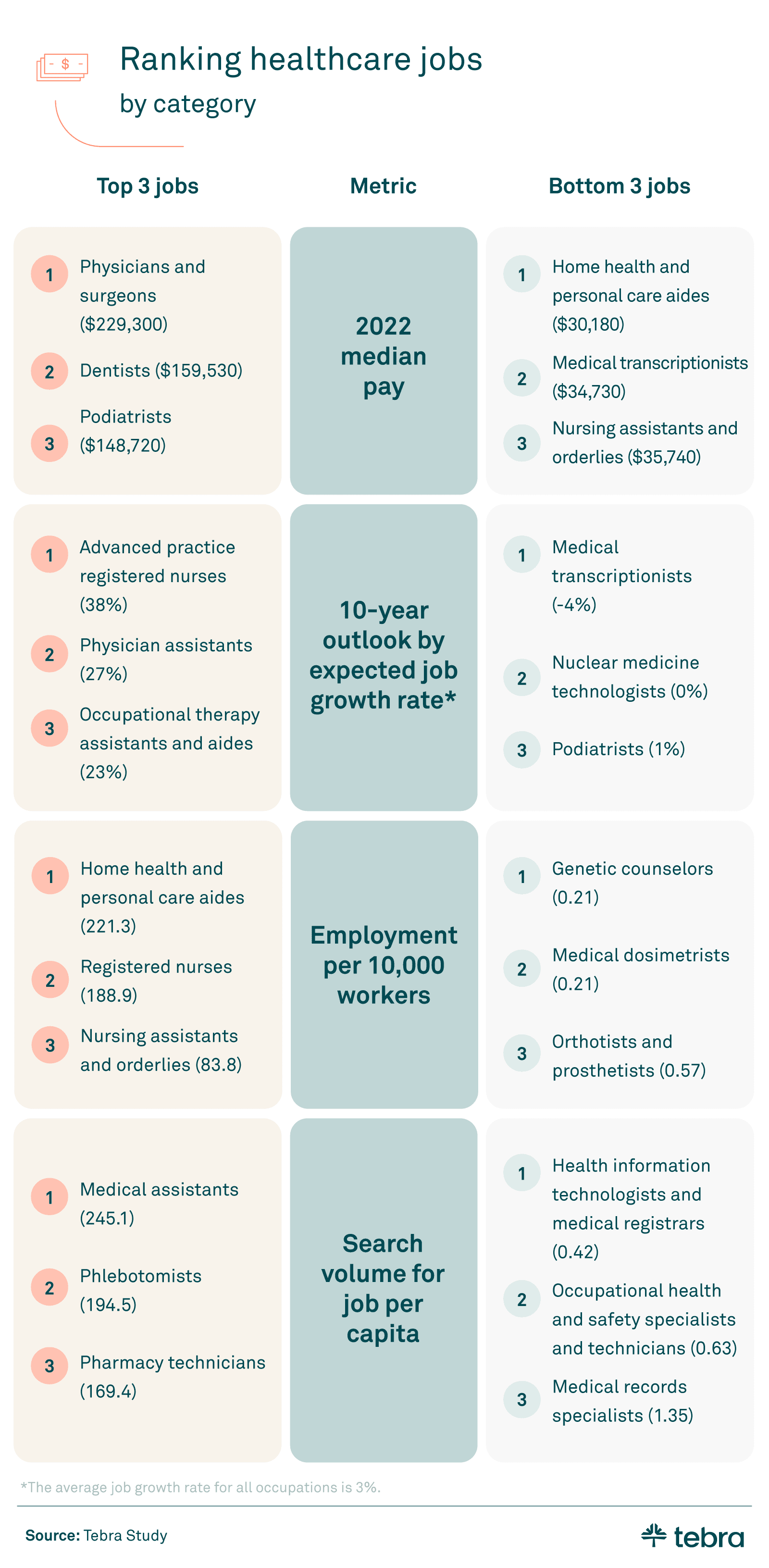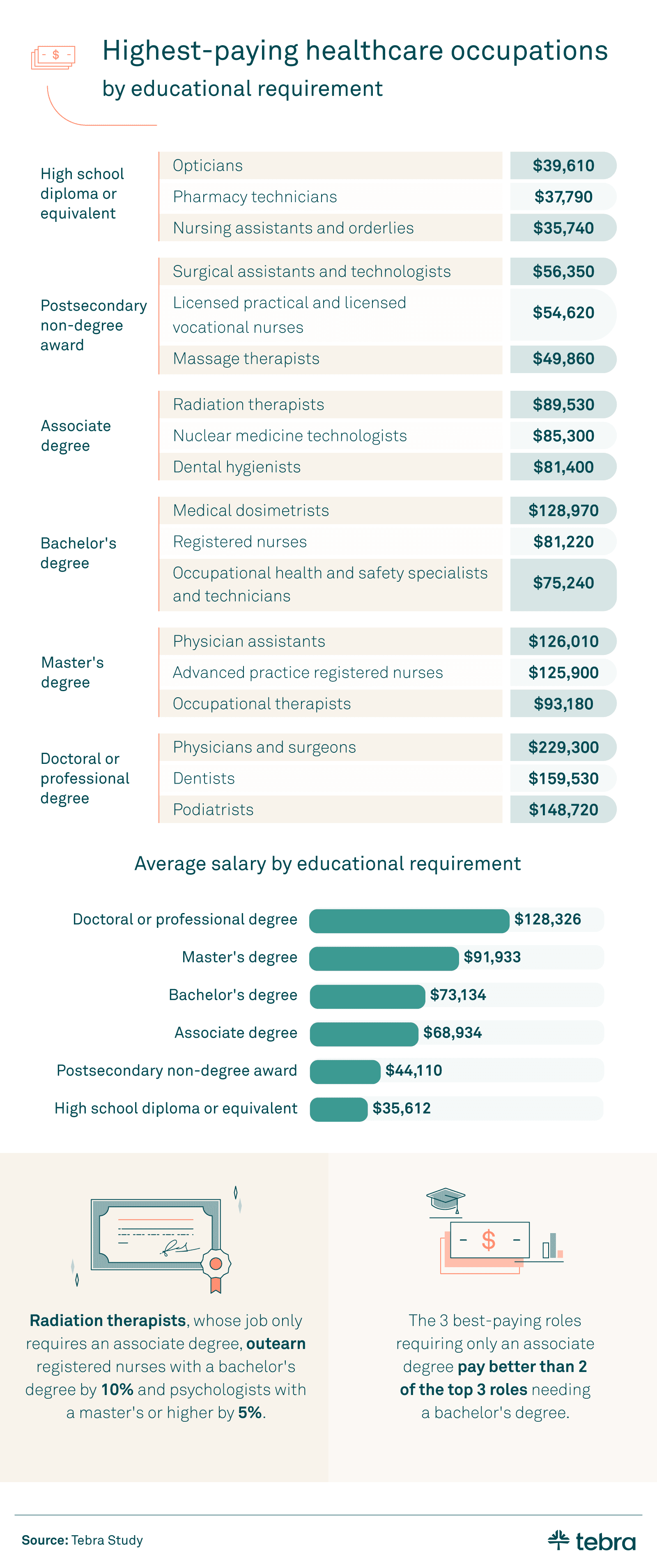The healthcare sector remains one of the most dynamic and essential industries in the global economy. As populations grow and age, the demand for medical services and care continues to surge, offering many job opportunities. Changing patient needs, government health initiatives, and recent technological advancements like medical artificial intelligence (AI) are transforming the industry, introducing roles that were once unimagined. What does this mean for those looking to enter the workforce or switch careers?
Several factors come into play when analyzing the job market outlook for healthcare. The industry isn’t just influenced by the immediate need for medical practitioners but also by long-term trends, economic indicators, and technological innovations. The healthcare field offers a variety of roles, from those demanding extensive specialization and education to those accessible with less formal training but still vital to patient care and system efficiency.
Our ranking of 46 healthcare occupations provides a comprehensive view of the current job market. This guide aims to help professionals, graduates, and students make informed career path choices and align their goals with the future of healthcare.
Key takeaways
- Of the jobs analyzed in the study, advanced practice registered nurses (APRNs) are ranked as having the best healthcare job.
- Experts project the need for APRNs will increase by 38% by 2032 — 12.7 times more than the average job growth rate for all occupations.
- Of the occupations analyzed in the study, home health and personal care aides have the highest employment rate per 10,000 workers (221.3).
- Radiation therapists, whose job only requires an associate degree, earn 10% more than registered nurses who need a bachelor’s degree.
Healthcare jobs ranked
For this study, Tebra ranked 46 healthcare industry jobs across the following variables:
- Median pay from the US Bureau of Labor Statistics Occupational Outlook Handbook
- 10-year job outlook based on expected job growth percentage
- Employment per 10,000 workers
- 2022-2023 search volume per capita for each job to determine interest
Occupations were scored on a scale of one to 100, and the table below shows the final rankings of the healthcare jobs in this study.

Of the jobs we ranked, APRNs emerged at the forefront with a final score of 86.3 out of 100. This category includes roles such as nurse practitioners, nurse midwives, and nurse anesthetists. APRNs’ impressive 10-year job growth outlook placed them first despite their median pay settling at seventh.
Although securing the second spot with a score of 80.8, home health and personal care aides were notable for their top employment rate (about 221 per 10,000 workers) but ranked 46th in median pay. Physician assistants, garnering a score of 80.2, showed promise in their sixth-place ranking for median pay and a favorable second-place 10-year outlook for job growth.
Conversely, we ranked medical transcriptionists, opticians, and recreational therapists the lowest of the 46 jobs we analyzed. These occupations had low employment rates, low median salaries, and poor job growth outlooks over the next decade.
These findings offer valuable insights to strategically steer a career in healthcare toward areas with the most robust growth and demand, ensuring workers’ goals align with the future needs of the industry. Let’s next take a closer look at the healthcare professions ranked highest and lowest across each metric for more insight.

Addressing the 10-year job forecast, a standout statistic was that APRNs anticipate a 38% growth by 2032. This projection is 12.7 times more than the average growth rate for all careers (3%), underscoring the burgeoning demand for these specialized healthcare roles. Physician assistants and occupational therapy assistants and aides also had impressive projected growth rates, at 27% and 23%, respectively. On the other hand, medical transcriptionist jobs were expected to decline by 4% by 2032.
The employment per 10,000 workers metric showed home health and personal care aides demonstrating unparalleled dominance, registering a peak employment rate of 221.3 per 10,000 workers. This prominence could be attributed to the relatively low barriers to entry into this profession, making it an accessible career option, and the demand for people to fill these roles to care for the aging baby boomer population.
When it came to jobs people are most interested in, “medical assistant jobs” had the highest search volume per 100,000 US residents (245.1), followed by “phlebotomist jobs” (194.5) and “pharmacy technicians jobs” (169.4). This indicates that more Americans are interested in these jobs than all the healthcare occupations in our study.
In the median pay spectrum in 2022, physicians and surgeons secured the top spot with a commendable annual salary of $229,300. Dentists ($159,530) and podiatrists ($148,720) rounded out the top 3 best-paying jobs. Conversely, home health and personal care aides and medical transcriptionists made the least among the occupations ranked, both coming in under $35,000 per year. This emphasizes the significant pay disparities in the healthcare sector, perhaps due to the differences in education required.
Higher education, higher salaries?
While many healthcare professions require extensive schooling, that isn’t the case for all. Below is a breakdown of the top-paying occupations by education level needed for entry-level employment. Our results might surprise you.

While we’ve seen that physicians and surgeons have impressive median salaries of over $220,000, committing 10-14 years of rigorous schooling can be daunting for many regarding time and financial investment. But although some roles have lower educational requirements, they can still outpace others in salary.
For instance, the top 3 highest-paying jobs for those with associate degrees — radiation therapist, nuclear medicine technologist, and dental hygienist — have higher salaries than two of the top 3 professions requiring bachelor’s degrees (registered nurses and occupational health and safety specialists and technicians).
Another significant highlight is the role of radiation therapists. Despite needing just an associate degree, they earned an impressive $89,530 in median pay, 10% more than registered nurses who typically need a bachelor’s degree to practice.
Navigating the healthcare job market
Healthcare is a vast and varied profession, but not all lucrative careers demand extensive academic commitments. Specific roles can outearn other professions that require more advanced education. Aspiring healthcare professionals must evaluate not just a job’s income potential but also the educational and time investment it requires and its projected job growth. This can help them make informed decisions aligned with their personal and financial goals. As the healthcare industry continues to evolve, so do its opportunities. Sometimes, the path less traveled can be the most rewarding.
Methodology
For this study, Tebra used the 2022 Bureau of Labor Statistics (BLS) data on healthcare occupations in the US to explore the healthcare job market outlook. Tebra based their ranking on the following variables, weighted as follows:
- Median pay from 2022 (30%)
- 10-year job outlook, expected job growth in percentage (30%)
- Employment per 10,000 workers (25%)
- 2022-2023 search volume per capita to determine the most sought-after roles (15%)
- For occupations grouped on BLS (for example, “physicians and surgeons”), Tebra used search volume for each (e.g., physician jobs, surgeon jobs) and determined the average.
The median wage refers to the 50th percentile wage estimate, meaning 50% percent of workers earn below the median, and 50% earn above it. Final scores were scaled by 1.7.
About Tebra
In 2021, with a combined mission to unlock better healthcare, Kareo and PatientPop joined forces to form Tebra — a complete practice automation solution for independent healthcare providers. With an all-in-one, purpose-built platform to drive practice success and modernize every step of the patient journey, Tebra provides digital tools and support to attract new patients, deliver modern care, get paid quickly, and operate efficiently. To learn more about how Tebra is committed to improving patients’ and providers’ success and well-being, visit www.tebra.com.
Fair use statement
All readers are welcome to share the findings presented in this article for non-commercial purposes only. When sharing, please provide a link back to this source.







